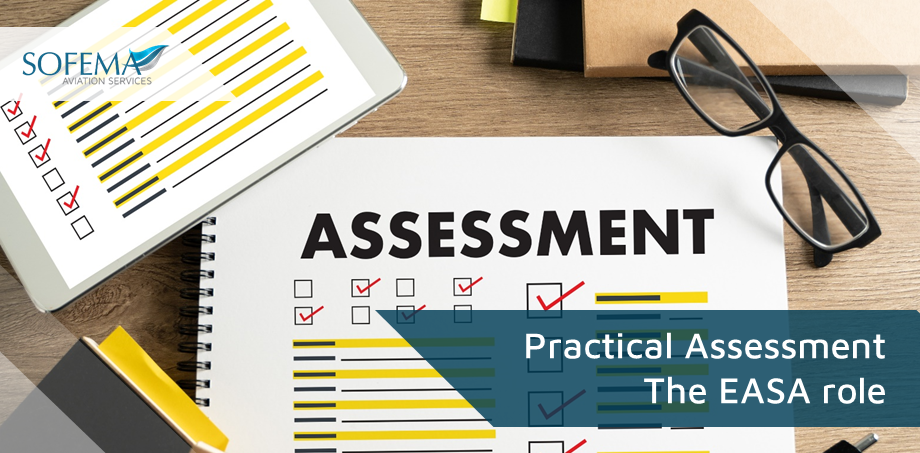Sofema Aviation Services (SAS) www.sassofia.com considers the terms, definitions and differences related to Practical Assessment from an EASA perspective.
Introduction
The practical assessment addresses the practical portion of any EASA Part 147 type training whereas the OJT assessment addresses the additional practical experience necessary to gain in a true maintenance environment as part of the first type rating in a (sub)category.
Reference Part 66 Appendix III General – 1b
Practical training and assessment shall comply with the following requirements:
(i) Shall be conducted by a maintenance training organisation appropriately approved by Annex IV (Part-147) or, when conducted by other organisations, as directly approved by the competent authority.
(ii) Shall comply, except as permitted by the differences training described in point (c), with the standard set out in point 3.2 of this Appendix and, if available, the relevant elements defined in the mandatory part of the operational suitability data established following Regulation (EU) No 748/2012.
(iii) Shall include a representative cross-section of maintenance activities relevant to the aircraft type.
(iv) Shall include demonstrations using equipment, components, simulators, other training devices or aircraft.
(v) Shall have been started and completed within the 3 years preceding the application for a type rating endorsement.
Practical Assessment
The purpose of Practical Assessment is to evaluate if the candidate has gained the required competence in performing safe maintenance, inspections and routine work according to the aircraft documentation and other relevant instructions and tasks as appropriate for the type of aircraft. (Reference: Appendix III, 3.2.)
The assessment shall be performed by designated assessors appropriately qualified. It means that the assessors should demonstrate training and experience in the assessment process being undertaken and be authorized to do so by the organisation. Guidance about the qualification is given in AMC to Part-66 Appendix III 3.)
- Applicable to Part 147 Type Training Candidates following practical element of training.
o Reference: 66.A.45 (a)&(b);
o AMC Appendix III
- Purpose is to perform the final evaluation of the knowledge, skills and attitude of the trainee following the practical element of the type training
o Reference: Appendix III 4.2.
- Practical Assessment is performed by Part-147 within an approved maintenance environment.
o (Part-145, with A rating, manufacturer) under the Part-147 approval
o Defined maintenance environment as described in the direct approved procedure by the competent authority (66.B.130) – Reference: Appendix III 1(b)
Practical Assessment Activities
According to EASA the assessment may be:
- Diagnostic (prior to a course)
o When a system has functionally failed, the equipment is clearly faulty. This is the domain of diagnostics and troubleshooting and in this scenario, a diagnosis examines the symptoms of an evident issue or problem.
o Functional failures demand reactive maintenance – essentially some form of urgent action after the failure has occurred. Reactive maintenance is, by definition, a surprise.
o Note – Prognosis A prognosis is a future prediction – in this case, the anticipation of a near-future failure.
o Essentially, a prognosis attempts to pin-point a looming failure while the system is behaving normally. A prognosis allows pre-emptive maintenance to take place, in an effort to avoid the looming failure.
- Formative
o The basis of the assessment process is to determine the progress of students, assess their knowledge, achievements, and competencies in a particular subject area
- Summative (partial or final evaluation)
o Summative assessment is the final evaluation of learning outcomes at the end of the instruction.
o It helps you measure the achievement of your participants, compare their results with predefined criteria or standards.
- Performed task-by-task
- Performed as a group of tasks
- Partly executed on simulation devices
- Performed as a final assessment
Next Steps
Follow this link to our Library to find & Download related documents for Free.
Please visit www.sassofia.com or see the following course EASA Part 147 Practical Instructors, Examiners/Assessors Training – Initial – 2 Days.
For comments or questions please contact team@sassofia.com
Tags:
Aircraft, EASA, Part 66, EASA Part 147, SAS blogs, Regulation (EU) No 748/2012, Practical Assessment, OJT assessment, Annex IV (Part-147), AMC to Part-66 Appendix III 3., Prognosis A, safe maintenance, training devices, type rating endorsement





